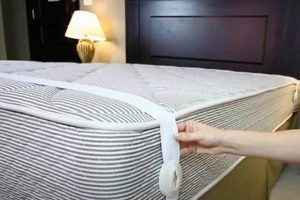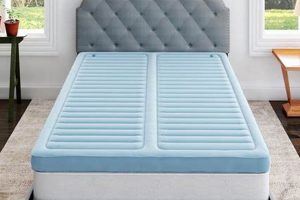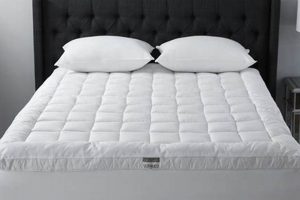A supportive layer placed atop a bed, specifically designed to alleviate pressure points associated with sciatic nerve pain, can offer enhanced comfort and promote better spinal alignment. These additions modify the firmness and feel of the existing sleeping surface, addressing a key factor in managing discomfort stemming from the lower back and legs. The selection of materials and construction is critical to its effectiveness.
The role of optimal sleep positioning and support in managing sciatica is well-documented. Using such a product can contribute to improved sleep quality, reduced pain perception, and potentially decreased reliance on pain medication. Historically, individuals have sought various methods to customize their sleeping environments to mitigate back and leg discomfort; these specialized items represent a modern approach to this enduring need.
The following sections will delve into material considerations, firmness levels, and key features to evaluate when selecting an appropriate aid for addressing sciatic discomfort. Furthermore, the impact of sleeping position and overall bed setup will be discussed in relation to optimizing pain relief and promoting restorative sleep.
Guidance on Selecting a Bed Overlay for Sciatic Relief
The selection of an appropriate bed overlay for mitigating sciatic discomfort requires careful consideration of several factors. Prioritizing spinal alignment and pressure relief is paramount.
Tip 1: Material Composition. Opt for materials known for pressure-relieving properties. Memory foam, latex, or a combination thereof, can effectively contour to the body, minimizing pressure on the sciatic nerve. Consider density and responsiveness of the material.
Tip 2: Firmness Level. A medium-firm to firm surface is generally recommended. Softer surfaces may lack adequate support, leading to spinal misalignment and exacerbation of sciatic pain. Evaluate personal comfort preferences in conjunction with support requirements.
Tip 3: Thickness Considerations. The thickness should be sufficient to provide adequate cushioning and support without causing excessive elevation. A range of 2-4 inches is generally suitable, but individual needs may vary.
Tip 4: Targeted Support Zones. Certain models incorporate zoned support, offering varying levels of firmness to different areas of the body. This can be particularly beneficial for individuals requiring additional support in the lumbar region.
Tip 5: Evaluate Density. Higher density materials tend to be more durable and provide better support over time. Lower density options may compress quickly, diminishing their effectiveness.
Tip 6: Consider Airflow. Some materials can trap heat, leading to discomfort during sleep. Opt for breathable materials or those with cooling technologies to maintain a comfortable sleep temperature.
Tip 7: Investigate Motion Isolation. If sharing a bed, consider models with good motion isolation properties to minimize disturbances caused by partner movement.
Selecting the right overlay can significantly contribute to improved sleep quality and reduced sciatic nerve discomfort. Prioritizing appropriate materials, firmness, and support features is essential.
The following sections will address the importance of supplementary elements, such as pillows and sleep positioning, in further enhancing sciatic pain management.
1. Firmness
Firmness, in the context of a mattress overlay intended to alleviate sciatica, directly influences spinal alignment and pressure distribution. An inappropriate firmness level can exacerbate sciatic nerve compression, leading to increased pain and discomfort. Too soft a surface may result in excessive sinking, compromising spinal support and placing undue stress on the lower back. Conversely, an overly firm surface may fail to contour to the body’s natural curves, creating pressure points that irritate the sciatic nerve. Individuals with sciatica often find relief with a medium-firm surface that balances support and pressure relief. The effectiveness of a mattress overlay depends substantially on the firmness that accommodates the individual’s weight and sleeping position.
Consider, for example, an individual weighing 200 pounds who primarily sleeps on their side. A softer overlay, while seemingly comfortable initially, may compress significantly under their weight, causing spinal misalignment and increased pressure on the sciatic nerve. A more appropriate choice would be a medium-firm option that provides adequate support and prevents excessive sinking. Conversely, a lighter individual weighing 120 pounds might find a very firm overlay unyielding and uncomfortable, creating pressure points on the hips and shoulders that radiate pain down the sciatic nerve. This illustrates the practical importance of selecting the appropriate firmness level based on individual body weight and sleeping habits to mitigate sciatic discomfort.
Ultimately, achieving optimal comfort and pain relief requires careful consideration of the firmness level in relation to individual needs. The selection process necessitates a thorough assessment of body weight, preferred sleeping position, and existing mattress characteristics. While a medium-firm option often serves as a suitable starting point, individual experimentation and consultation with a healthcare professional may be necessary to determine the most effective firmness level for managing sciatic symptoms. Choosing the correct firmness ensures the product provides both effective support and pressure reduction.
2. Material Density
Material density, a crucial factor in the context of mattress overlays for sciatica, refers to the mass of the material per unit volume. This characteristic significantly influences the overlay’s ability to provide adequate support and pressure relief, directly impacting sciatic nerve pain. Higher density materials, such as high-density memory foam or latex, offer superior support and durability compared to lower density counterparts. They resist compression and deformation, maintaining their shape and support over extended periods. This sustained support is vital for maintaining proper spinal alignment and reducing pressure on the sciatic nerve. If the material is too low density, it will compress quickly under body weight, negating any potential benefits for sciatic relief. For example, a low-density foam may initially feel soft but will soon bottom out, failing to provide adequate support for the lumbar region and potentially exacerbating sciatic symptoms.
The practical implication of understanding material density lies in its direct relationship to the lifespan and effectiveness of the mattress overlay. A high-density overlay will not only provide more consistent support but also resist sagging and indentation, common issues with lower density materials. This durability translates to a l
onger period of effective pain relief. Furthermore, material density influences the overlay’s ability to evenly distribute body weight. This even distribution minimizes pressure points, particularly in the hips and shoulders, which can contribute to sciatic nerve irritation. A patient weighing 200 pounds will experience significantly different levels of support and pressure relief on a high-density versus a low-density overlay, even if both overlays have the same stated firmness. The higher density material will offer a more stable and supportive surface, preventing excessive sinking and maintaining spinal alignment.
In summary, material density is a primary determinant of a mattress overlay’s effectiveness in mitigating sciatic pain. Higher density materials provide enhanced support, durability, and pressure distribution, leading to improved spinal alignment and reduced sciatic nerve compression. Selecting a product with an appropriate material density is essential for achieving long-term comfort and pain relief. While initial cost considerations may favor lower density options, the long-term benefits of higher density materials, in terms of durability and sustained support, often outweigh the initial investment. The choice, therefore, should be based on a thorough assessment of material properties and the individual’s specific needs and weight.
3. Pressure Relief
Pressure relief is a primary consideration when selecting a bed overlay for individuals experiencing sciatic discomfort. The overlay’s capacity to redistribute body weight and alleviate concentrated pressure points is directly correlated with the reduction of sciatic nerve compression and associated pain.
- Conforming Materials and Pressure Redistribution
Materials such as memory foam and latex exhibit viscoelastic properties, allowing them to conform to the body’s contours. This characteristic facilitates the distribution of weight over a larger surface area, reducing peak pressure points that can irritate the sciatic nerve. For example, an overlay that conforms to the curvature of the spine minimizes pressure on the lumbar region, a common source of sciatic nerve compression.
- Zoned Support Systems
Some bed overlays incorporate zoned support systems, featuring varying levels of firmness in different areas. This design caters to the specific pressure relief needs of different body regions. A softer zone beneath the shoulders and hips allows for greater sinkage, minimizing pressure, while a firmer zone in the lumbar region provides support and prevents spinal misalignment. This targeted approach maximizes pressure relief in areas prone to sciatic nerve irritation.
- Impact on Circulation
Prolonged pressure on tissues can impede blood circulation, potentially exacerbating pain and discomfort. An overlay that effectively relieves pressure promotes healthy circulation, allowing oxygen and nutrients to reach tissues more efficiently. Improved circulation can reduce inflammation and accelerate healing processes, contributing to sciatic pain relief.
- Influence on Sleep Quality
Pain and discomfort caused by pressure points can disrupt sleep, leading to fragmented sleep cycles and reduced overall sleep quality. A bed overlay designed for pressure relief can promote more comfortable and restful sleep, allowing the body to recover and heal. Improved sleep quality can, in turn, reduce pain perception and improve overall well-being.
The multifaceted nature of pressure relief underscores its importance in the selection of a bed overlay for sciatica. The ability to redistribute weight, provide zoned support, promote circulation, and improve sleep quality collectively contributes to the mitigation of sciatic nerve compression and associated pain. The optimal selection process should consider these facets to maximize the overlay’s therapeutic potential.
4. Spinal Alignment
Maintaining proper spinal alignment is paramount in mitigating sciatic pain. A mattress overlay’s ability to support the natural curvature of the spine directly influences pressure distribution on the sciatic nerve. Optimal alignment reduces strain and compression, contributing to pain reduction and improved sleep quality.
- Neutral Spine Position
A neutral spine position, characterized by the natural curves of the cervical, thoracic, and lumbar regions being maintained, is crucial for minimizing sciatic nerve compression. A suitable mattress overlay promotes this position by providing adequate support to prevent excessive sinking or arching of the spine. For instance, a side sleeper requires an overlay that fills the gap between the mattress and their waist to maintain spinal alignment, preventing the upper hip from dropping and twisting the spine.
- Lumbar Support
The lumbar region, or lower back, is a common site of sciatic nerve irritation. An overlay that provides targeted lumbar support helps maintain the natural inward curve of the lower back, reducing strain on the spinal discs and nerves. Individuals with pronounced lordosis (an exaggerated lumbar curve) may benefit from an overlay with enhanced lumbar support to prevent further exacerbation of their condition. Lacking lumbar support can cause excessive arching of the lower back, compressing the sciatic nerve where it exits the spine.
- Pelvic Alignment
Proper pelvic alignment is intrinsically linked to spinal alignment. An overlay that allows the pelvis to remain level prevents rotation or tilting, which can contribute to uneven pressure distribution on the sciatic nerve. A level pelvis ensures that the spinal column is properly supported from its base, minimizing strain throughout the spine. When the pelvis is misaligned, the muscles supporting the spine must work harder to maintain stability, which can lead to fatigue and pain.
- Influence of Sleeping Position
The ideal spinal alignment varies depending on the preferred sleeping position. Side sleepers require an overlay that accommodates the curvature of the spine while preventing excessive pressure on the shoulders and hips. Back sleepers benefit from an overlay that supports the natural arch of the lower back. Stomach sleeping is generally discouraged due to the strain it places on the neck and spine; however, if unavoidable, a thinner, firmer overlay is often recommended to minimize spinal hyperextension. Adjustments to the overlay may be necessary to achieve optimal spinal alignment based on individual sleeping habits.
These aspects of spinal alignment are critical in evaluating the suitability of a mattress overlay for alleviating sciatic pain. Selecting an overlay that promotes a neutral spine position, provides targeted lumbar support, maintains proper pelvic alignment, and accommodates individual sleeping positions will contribute significantly to reducing pressure on the sciatic nerve and improving overall comfort. Addressing the interplay of these points is essential for proper spine health.
5. Heat Dissipation
Excessive heat retention within a mattress overlay can compromise
sleep quality, potentially exacerbating sciatic discomfort. The connection between effective heat dissipation and a supportive bed overlay for sciatica lies in the interplay between body temperature regulation and pain perception. A cooler sleep environment can reduce inflammation and muscle tension, both factors contributing to sciatic nerve irritation. Overlays constructed with materials that inhibit airflow trap body heat, leading to increased sweating and discomfort, disrupting sleep patterns and potentially increasing sensitivity to pain signals. Therefore, the selection of a bed overlay that promotes heat dissipation is a crucial consideration for individuals seeking relief from sciatica.
Materials exhibiting open-cell structures, such as certain types of memory foam or latex, facilitate better airflow compared to closed-cell counterparts. Furthermore, some overlays incorporate cooling technologies, such as gel infusions or phase change materials, designed to actively dissipate heat away from the body. For instance, an individual residing in a warmer climate experiencing sciatic pain may find significant relief from an overlay utilizing gel-infused memory foam, as the gel helps to regulate temperature and prevent heat build-up throughout the night. Conversely, a standard memory foam overlay lacking cooling properties may contribute to increased sweating and discomfort, negatively impacting sleep quality and potentially worsening sciatic symptoms. The presence or absence of effective heat dissipation mechanisms represents a tangible difference in user experience and therapeutic benefit.
In summary, effective heat dissipation is a vital component of a suitable mattress overlay for sciatica. The ability to regulate body temperature and maintain a comfortable sleep environment can directly influence pain perception, inflammation, and sleep quality. Selecting overlays with breathable materials or integrated cooling technologies is paramount for maximizing therapeutic benefits and minimizing potential disruptions to sleep caused by heat retention. Failing to consider this aspect may negate other beneficial features of the overlay, leading to suboptimal outcomes in managing sciatic discomfort. The user benefits from a product designed to mitigate the negative impact of body heat.
6. Motion Isolation
Motion isolation, referring to a mattress overlay’s capacity to absorb and minimize the transfer of movement, is a relevant consideration for individuals managing sciatica, particularly those sharing a bed. Disruptions caused by a partner’s movements during sleep can lead to fragmented sleep patterns, hindering the body’s natural restorative processes. When sleep is interrupted, pain perception may increase, and the effectiveness of pain management strategies can be diminished. An overlay exhibiting effective motion isolation properties can mitigate these disturbances, contributing to improved sleep quality and potentially lessening sciatic discomfort.
The mechanism by which certain materials enhance motion isolation lies in their ability to dampen vibrations and limit the spread of movement across the sleeping surface. Memory foam and latex, for instance, are known for their capacity to absorb motion, preventing it from transferring to other areas of the bed. Consider a scenario where one partner frequently changes sleeping positions throughout the night. Without adequate motion isolation, these movements would likely be felt by the other partner, potentially disrupting their sleep and aggravating sciatic symptoms. A mattress overlay incorporating high-density memory foam would minimize the transmission of these movements, allowing for more undisturbed sleep. Selecting a topper with good motion isolation allows for a more calm night.
In summary, motion isolation represents an important aspect of a mattress overlay’s suitability for individuals with sciatica who share a bed. By minimizing sleep disruptions caused by partner movement, these overlays can contribute to improved sleep quality and potentially reduce pain perception. While motion isolation alone may not directly alleviate sciatic pain, its role in promoting restorative sleep makes it a valuable feature to consider. Therefore, when evaluating options, one should take into account the necessity of reducing external disruptions for optimized comfort.
7. Thickness
The thickness of a bed overlay significantly influences its capacity to alleviate sciatic discomfort. As a primary determinant of cushioning and support, the overlay’s thickness directly affects spinal alignment and pressure distribution, both critical factors in managing sciatic nerve compression. Insufficient thickness may fail to provide adequate contouring and support, rendering the overlay ineffective in relieving pressure points. Conversely, excessive thickness may create an unstable sleeping surface, disrupting spinal alignment and potentially exacerbating sciatic symptoms. The selection of an appropriate thickness must consider individual weight, sleeping position, and the existing mattress characteristics.
A bed overlay designed to mitigate sciatica requires a balance between providing ample cushioning and maintaining a stable, supportive base. For example, an individual weighing 200 pounds who sleeps on their side typically requires a thicker overlay (3-4 inches) to adequately cushion the hips and shoulders and prevent spinal misalignment. A thinner overlay may compress excessively under the weight, failing to provide sufficient pressure relief. In contrast, a lighter individual weighing 120 pounds may find that a thinner overlay (2-3 inches) provides adequate support without compromising spinal alignment. Moreover, the existing mattress firmness plays a crucial role in determining the appropriate thickness. A softer mattress may require a thicker overlay to compensate for the lack of underlying support, while a firmer mattress may benefit from a thinner overlay primarily intended to provide additional cushioning.
In summary, the thickness of a bed overlay is a critical factor in its effectiveness in alleviating sciatic discomfort. Appropriate thickness ensures adequate cushioning and support, promoting spinal alignment and reducing pressure on the sciatic nerve. The ideal thickness varies based on individual weight, sleeping position, and the characteristics of the existing mattress. While general guidelines suggest a range of 2-4 inches, individual experimentation and consultation with healthcare professionals may be necessary to determine the most suitable thickness for managing specific sciatic symptoms. An understanding of how firmness and thickness interact ensures the best solution.
Frequently Asked Questions
The following addresses common inquiries regarding the selection and utilization of bed overlays designed to mitigate sciatic discomfort.
Question 1: What is the optimal firmness level for a mattress overlay intended to alleviate sciatica?
A medium-firm to firm support level is generally recommended. Softer surfaces may lack adequate support, contributing to spinal misalignment and exacerbation of sciatic symptoms. Personal preferences and body weight should also be considered.
Question 2: What materials are most suitable for a mattress overlay designed to reduce sciatic pain?
Memory foam and latex are commonly recommended due to their pressure-relieving properties and ability to conform to the body’s contours. These materials as
sist with weight distribution and reducing pressure on the sciatic nerve.
Question 3: How does the thickness of a mattress overlay impact its effectiveness in alleviating sciatica?
The thickness influences the level of cushioning and support provided. A range of 2-4 inches is generally suitable, but the ideal thickness will vary depending on body weight, sleeping position, and the firmness of the underlying mattress.
Question 4: Can a mattress overlay correct an existing spinal misalignment that contributes to sciatica?
A bed overlay can aid in maintaining proper spinal alignment during sleep but cannot correct pre-existing structural issues. Consulting with a healthcare professional is recommended for addressing underlying spinal conditions.
Question 5: How frequently should a mattress overlay be replaced to ensure continued effectiveness in managing sciatica?
The lifespan of a mattress overlay varies depending on material quality and usage. High-density materials generally last longer. Signs of wear, such as sagging or loss of support, indicate a need for replacement.
Question 6: Are there any potential drawbacks to using a mattress overlay for sciatica?
Some individuals may experience an adjustment period when transitioning to a new mattress overlay. Additionally, certain materials can retain heat, potentially leading to discomfort. Selecting breathable materials or those with cooling properties can mitigate this issue.
Proper selection and consistent use of a suitable bed overlay can contribute to improved sleep quality and reduced sciatic discomfort.
The following section will discuss adjunct therapies and lifestyle modifications that can complement the use of a mattress overlay in managing sciatica.
Conclusion
The preceding discussion has explored the multifaceted aspects of a mattress topper for sciatica, emphasizing the importance of material composition, firmness, thickness, and other crucial characteristics. Selecting an appropriate product requires careful consideration of individual needs and preferences, balancing support, pressure relief, and thermal regulation to optimize sleep quality and minimize sciatic nerve irritation. The information presented serves as a guide for making informed decisions.
Ultimately, the effectiveness of a mattress topper for sciatica is contingent upon individual circumstances and adherence to comprehensive pain management strategies. While a suitable topper can significantly contribute to mitigating discomfort, it is essential to recognize its role as one component of a broader approach that may include physical therapy, medication, and lifestyle modifications. Continued research and consultation with healthcare professionals remain vital for optimizing outcomes in managing sciatica.







